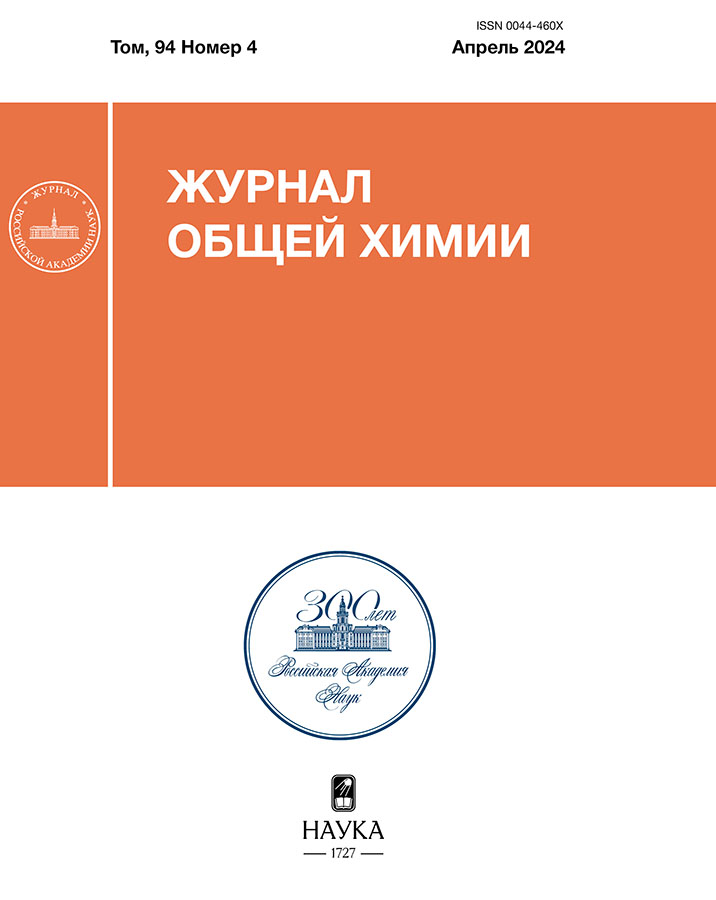Volume 94, Nº 4 (2024)
- Ano: 2024
- Artigos: 7
- URL: https://cardiosomatics.ru/0044-460X/issue/view/11994
Edição completa
Articles
Synthesis of Diethyl 6-Amino-1-aryl-2-oxo-1,2-dihydropyridine-3,5-carboxylate
Resumo
It was found that the reaction of malonic acid N-arylamidoesters with ethyl 2-cyano-3-ethoxyacrylate in ethanol in the presence of equimolar amounts of triethylamine both at room temperature and under reflux leads to the formation of previously unknown diethyl 6-amino-1-aryl-2-oxo-1,2-dihydropyridine-3,5-carboxylates with yields of 40–70%. Structure of the obtained compounds was confirmed by NMR and IR spectroscopy data. Antibacterial activity of some of the obtained compounds was studied.
 462-468
462-468


1,3-dipolar cycloaddition as a method for the synthesis of dipyrrolidinyl- and dipyrrolylketones
Resumo
In the reactions of 1,3-dipolar cycloaddition of a twofold excess of aryl aldimines of glycine ethyl ester with diarylideneacetones and diarylidenecyclohexanones in the presence of silver acetate, the corresponding dipyrrolidinylketones were obtained. Diethyl 4,4′-carbonylbis(3,5-diarylpyrrolidine-2-carboxylates) obtained from diarylideneacetones undergo aromatization under the action of N-bromosuccinimide to form diethyl 4,4′-carbonylbis(3,5-diaryl-1H-pyrrole-2-carboxylates). The selectivity of the reactions and the structure of the products were determined using correlation NMR spectroscopy and X-ray diffraction analysis.
 469-488
469-488


Interconversions of 1,3-dipolar cycloaddition products of azomethine ylides and ylidenemalononitriles
Resumo
New substituted spiropyrrole(zi)dynes were synthesized by the 1,3-dipolar cycloaddition reaction of ylidenemalononitriles and azomethine ylides generated in situ by condensation of isatin and α-amino acids (sarcosine, proline). The products′s features of the regio- and diastereochemical structure were elucidated depending on the nature of the amino acid and the reaction conditions. Based on data from the analysis of the spectra of cycloaddition products obtained under various conditions, as well as some additional experiments, a probable scheme for the formation of products was proposed, including retro-1,3-dipolar cycloaddition and the retro-Mannich reaction. Methods for the selective synthesis of isomeric spiropyrrolizidines were developed.
 489-502
489-502


Oxidative heterocoupling of lithium 2-methylpropanoate α-carbanion and secondary α-carbanions of lithium acylates
Resumo
When the α-carbanion of 2-methylpropanoate (A) reacts with the α-carbanions of lithium butanoate, pentanoate, hexanoate, heptanoate and phenylacetate (B) in the presence of 1,2-dibromoethane, a mixture of oxidative homocoupling (A-A, B-B) products [2,2,3,3-tetramethyl- and 2,3-diethyl- (or 2,3-dipropyl-, 2,3-dibutyl-, 2,3-dipentyl-, 2,3-diphenyl)succinic acids] and heterocouplings (A-B) products [2,2-dimethyl-3-ethyl- (or 2,2-dimethyl-3-propyl-, 2,2-dimethyl-3-butyl-, 2,2-dimethyl-3 -pentyl-, 2,2-dimethyl-3-phenyl)succinic acids] is formed with a total yield of 84–98%. The effect of the nature of the oxidizing reagent (1,2-dibromoethane and other reagents) and the molar ratio of coupling α-carbanions of lithium acylates on the selectivity of the formation of homo- and heterocoupling products was studied.
 503-510
503-510


Extraction and sorption recovery of rhenium(VII) using oligodentate β-аminophosphoryl compounds
Resumo
The interphase distribution of microquantities of ReO4– between aqueous solutions of mineral acids and solutions of oligodentate β-aminophosphoryl compounds in organic solvents was studied. The stoichiometry of the extracted complexes was determined, the influence of the concentration of HClO4, HNO3, HCl and H2SO4 in the aqueous phase, the structure of the extractant and the nature of the organic solvent on the efficiency of the transition of ReO4– ions into the organic phase was considered. The possibility of selective extraction and concentration of Re(VII) with a complexing sorbent obtained by non-covalent attachment of tris[bis(2-diphenylphosphorylethyl)aminoethyl]amine on the surface of the macroporous polymer Amberlite XAD7HP was demonstrated.
 511-518
511-518


Synthesis and some properties of magnesium and zinc tetra-3-(4-bromophenoxy)phthalocyanines
Resumo
The work describes the synthesis of non-periphery substituted Zn(II), Mg(II) phthalocyanines complexes obtained from 3-(4-bromophenoxy)phthalonitrile. The influence of the metal complex on the spectral and acid-base properties of the obtained compounds was shown. The quantum yield and fluorescence lifetime of the synthesized metal complexes were determined.
 519-527
519-527


Oxygen-containing compounds in polydimethylsilanes and -carbosilanes
Resumo
An analysis of fractions extracted from polydimethylsilanes, as well as distillates obtained during the synthesis of poly(oligo)carbosilanes was carried out. By the methods of gel permeation chromatography and chromatography-mass spectrometry, the range of molecular weights in extracts and distillates, the composition and structure of compounds, as well as the sequence of their retention times on the chromatographic column were determined. It was established that the compounds extracted from polydimethylsilanes are low molecular weight cycles containing methylsilane and/or methylsiloxane units. In distillates, compared with extracts, the number of low molecular weight compounds containing individual or mixed methylsilane, carbosilane and siloxane units increases.
 528-542
528-542












